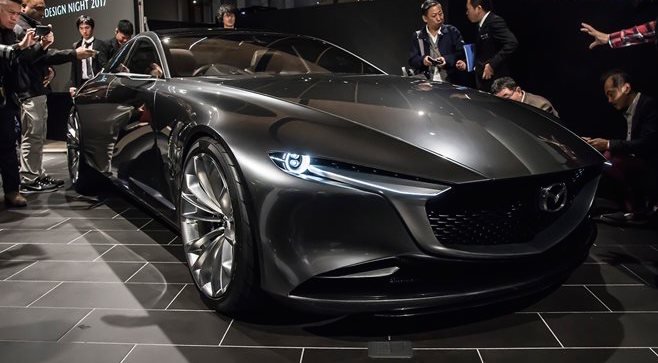Mazda Vision Coupe | Tokyo Motor Show's big, sensuous sedan

Enough that we started to think it might show a new epitrochoid-engined concept at this year's Tokyo Motor Show. But the brand is nothing if not surprising. Have you driven a CX-5 or a CX-9? Have you noted the real-world fuel economy in a Mazda3? Have you looked at a Miata RF?
So instead of trotting out the latest in Wankel weirdness, today in its home market, the Mazda folks pulled the silk off of a stunning full-size four-door design concept, the somewhat inaptly named Vision Coupe.
Known mainly for sporty and affordable small(ish) vehicles, Mazda hasn't really had an entry in this category since ... ever. Well, save for the staid and short-lived 929 of the '90s (and the rotary-powered, 7/8-scale Olds Cutlass, JDM-only Roadpacer of the '70s.) As customers flock to crossovers, it's not exactly a category brimming with vitality, at least in the American market — sales of the existing Mazda 6 are down in the States by nearly 25 percent this year, double the market average for cars. And this thing is bigger than that.
But the decision is intentional and strategic in Mazda's mission to head upscale and focus on clean design — differentiators from its mass-market Japanese peers.
"A big sedan has always been the symbol of a brand going premium. It's the icon of a brand," says Julien Montousse, Mazda North America's director of design. "It tells that Mazda is becoming serious in reaching that goal."
Breaking even more conventions, while Mazdas generally are cohesive and well-rendered in their design, you would be hard-pressed to find one quite this sensuous. The Vision Coupe looks like an Aston Martin Rapide that has been placed in a sauna until its body-mass index has whittled down to marathoner levels, and then scalloped and stripped of any unnecessary ornamentation, save for a kind of fingerprinted whorl in its side cove. It is elemental, at once planar and burnished, with the lovely long-hood/short-deck proportions of a classic front-engine, rear-wheel-drive grand tourer.
Its interior is similarly edited, doing away with the proliferating screens of other vehicles in the category, utilizing instead a digital analog instrument panel and a sophisticated heads-up display that keeps a driver focused on the road and shows just what is deemed necessary, and nothing else.
"Outside and inside, it follows a Japanese aesthetic, moving away from an animalistic approach, away from too much dynamism, to become something more minimal," says Montousse. "But it is not mathematical or rigid. It is very fluid, meant to communicate a human trace behind it. It is a way to define and induce a specific feeling that connects a human energy to the product. To encourage pure love."
Mazda is big on this idea of automotive affection, especially in light of the recent industry-wide push into semi-autonomy, which seems intended to separate the car from its owner/user/mobility participant. The brand believes that the deep connection between humans and their machines should not be rendered invisible or discontinuous, but should be maintained, and even enhanced. Moreover, Mazda believes that this connection should be, and remain, both physical and emotional.
This makes sense for a driver-centric brand that privileges stick shifts, steering feel and zoom-zooming.
"Mazda has made it clear that it is not going to follow the autonomous trend," Montousse says. "Instead of the car acting as a cocoon, a personal assistant, to insulate and isolate, we believe it should be a copilot. To be there to enable bravery, and give you the tools to face the aggression."
Related News


